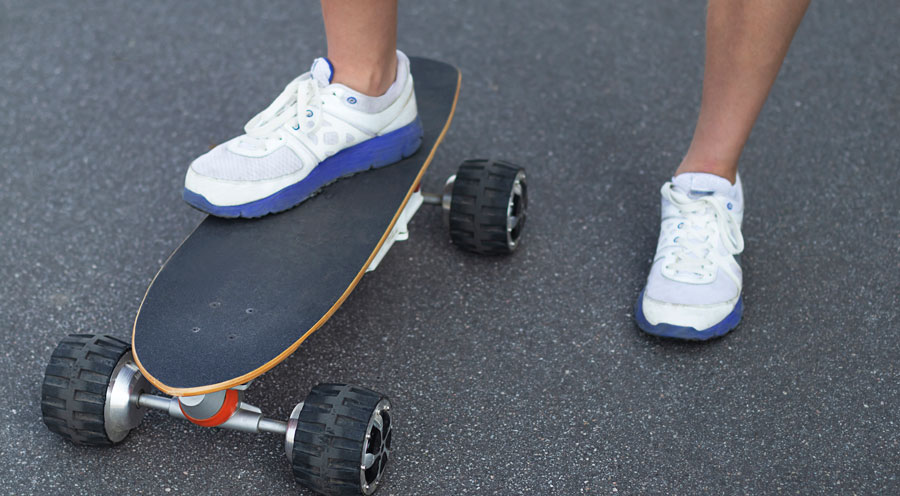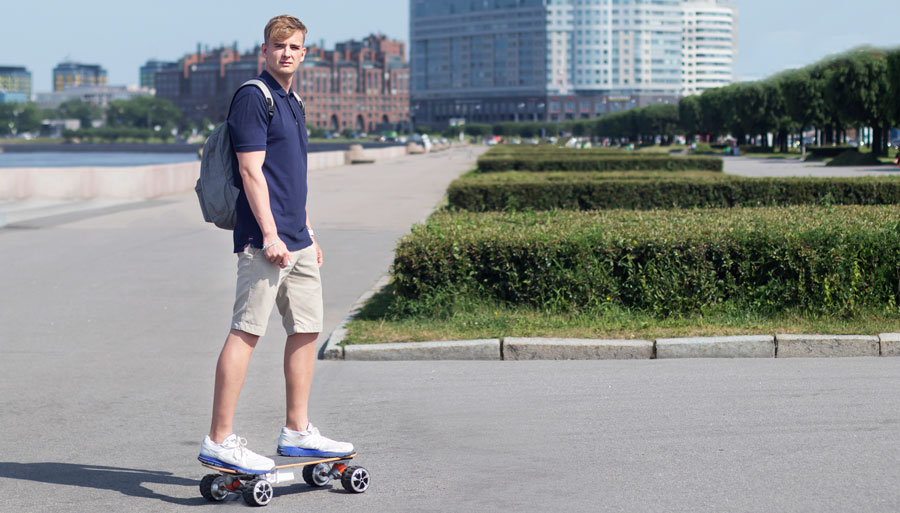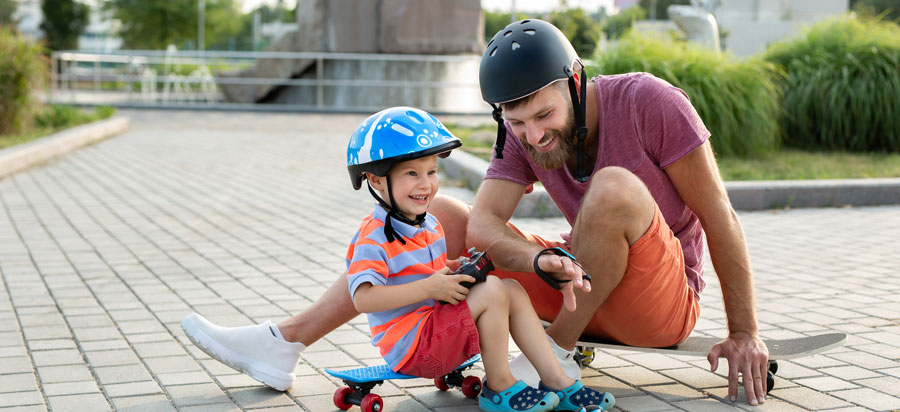Electric skateboards are easy to ride but take a little practice to get used to. With an electric skateboard, you use a remote control to accelerate and brake the board. Similar to normal skateboards, you lean your weight to turn (or carve) on the board.
In this article, we’ll explain some of the differences between a conventional skateboard and an electric skateboard and look at how long it would take you to learn.

Are they easier than regular skateboards
Electric skateboards share many similarities with normal skateboards. They’re fun and easy to learn how to use and if you have any experience with riding a normal skateboard, you’ll be pretty familiar with how to control an electric skateboard.
In fact, many people claim that riding an electric skateboard is actually easier than riding a normal skateboard. First, you don’t need to propel yourself on an electric skateboard as the motor allows the rider to accelerate and decelerate with the aid of the remote control.
Electric skateboards are also modelled on a longer and flatter board design, which many agree is easier to ride and more forgiving when riding over small bumps and cracks in the pavement.
Differences between an electric skateboard and a normal skateboard
Electric skateboards are more like normal longboards in size and appearance. Longboard designs vary, but generally, they have a long flat board shape that is around 3 feet long. Longboards do not usually have upturned ends as they are more intended for cruising and speed, rather than attempting ollies, nollies, and other skateboarding tricks.
Electric skateboards use a similar board design to a traditional longboard. The board is heavier and slightly thicker due to the extra components that are hidden beneath the board.
Electric skateboards use a rechargeable battery to power small motors hidden within the hub or axle component of the board. These motors are controlled by a wireless remote control that allows the rider to accelerate and brake.
Are they difficult to steer and turn corners?
Steering an electric skateboard is very similar to riding and turning on a normal skateboard. In both cases, when riding straight you distribute your weight centrally over the board. To turn, you simply lean your body weight slightly in the direction of the corner. The redistribution of your body weight turns the board.
The good news is no matter if you’re using a normal skateboard or electric skateboard, the method for turning is the same!
Carving on an electric skateboard
More experienced skateboarders and longboarders will also use carving to turn. Carving involves a crouched stance on the board and thrusting your rear foot forward, this causes the back wheels to slide (or drift) out and then you carefully use your body weight to maintain the drift around a corner.
The advantages of carving on an electric skateboard are you can control the power to the wheels via remote control so you don’t need to rely on downhill momentum. This opens up the opportunity for flat ground carving! Carving takes time to practice and get right, but once you’ve mastered carving, corners are much more fun!
How long will it take to learn?
Learning how to ride an electric skateboard is pretty easy, but feeling comfortable on the board and pushing it to top speed may take some time. Take your time and practice on flat even pavement a little each day and you’ll quickly learn balancing and controlling the board.
The time it takes to learn how to balance and turn on an electric skateboard will vary from one person to the next and really depends on a few factors.
Previous experience on boards is a big bonus, and if you’ve logged any time on a normal skateboard, you’ll already be very familiar with the feeling of riding an electric skateboard. Once you’ve got used to the extra weight and length of the electric skateboard, it’s just a matter of getting used to using the remote control to power and brake on the board.
Coordination is also important when learning to ride an electric skateboard. You’re using your feet to steer the board, your body to balance and distribute your weight evenly, and your hands control acceleration and braking. Novice riders can get a little confused with so much happening at the same time.
What’s the fastest way to learn to ride an electric skateboard?

- Take it slow, learn at your own pace and don’t push your board to top speeds until you feel 100% comfortable
- Learn on flat, smooth surfaces with no traffic or obstacles
- Always use protective equipment whenever riding
- Practice turns at a low speed and gradually increase your speed while practising turns
- Practice bailing off your board at lower speeds. This will prepare you for the real thing, as at some point, you’ll need to bail off your board at higher speeds!
Do you have to be able to ride a skateboard before getting a boosted board?
No, while it’s advantageous to have some experience on a normal skateboard, it’s not totally necessary. Electric skateboards are easy enough to learn with no prior experience on any type of skateboard.
Taking precautions
Like any board sport, it’s important to take some precautions whenever learning to ride your electric skateboard. Always start out slow and never try to reach maximum speed until you feel very familiar with your board and the terrain you’re riding on. Some electric skateboards can reach top speeds in excess of 20 mph which can cause some serious damage or injuries if you crash.
When learning, find an area with an even flat surface that doesn’t have any obstacles or traffic. Never attempt to learn on the street, as manoeuvring around foot or vehicle traffic can be tricky for novice riders.
Always use protective gear

No matter how experienced you are or feel on your electric skateboard, you should always wear protective equipment. The most common injuries on skateboards are head, hand, and arm related injuries, and serious injuries can occur even at lower speeds where people tend to fall awkwardly.
Inexperienced riders should always use a helmet, wrist, elbow and knee guards. Gloves are also a good idea for preventing gouging your hands on rough surfaces. A back guard is also worth considering while you’re learning. Keep your speed low while learning and try to practise on smooth even pavement to prevent gravel rash!
Once you have mastered your electric skateboard, it’s likely you’ll want to use it for commuting and this can involve using it in high traffic areas. No matter how experienced you are, your head doesn’t get any harder and is still vulnerable to impact and serious injury, so always, ALWAYS wear a helmet whenever you ride.
Summary
Electric skateboards are awesome! They’re fun to ride, easy to learn, and great for commuting short distances around town. Technology is making them much cheaper and lighter and nowadays, there’s very little visual difference between a normal board and an electric skateboard. Some electric skateboards can reach top speeds in excess of 20 mph so it’s important to always wear protective gear.